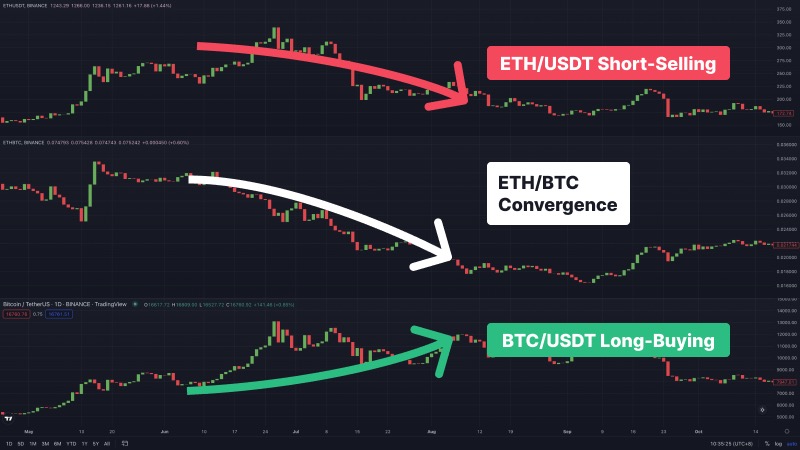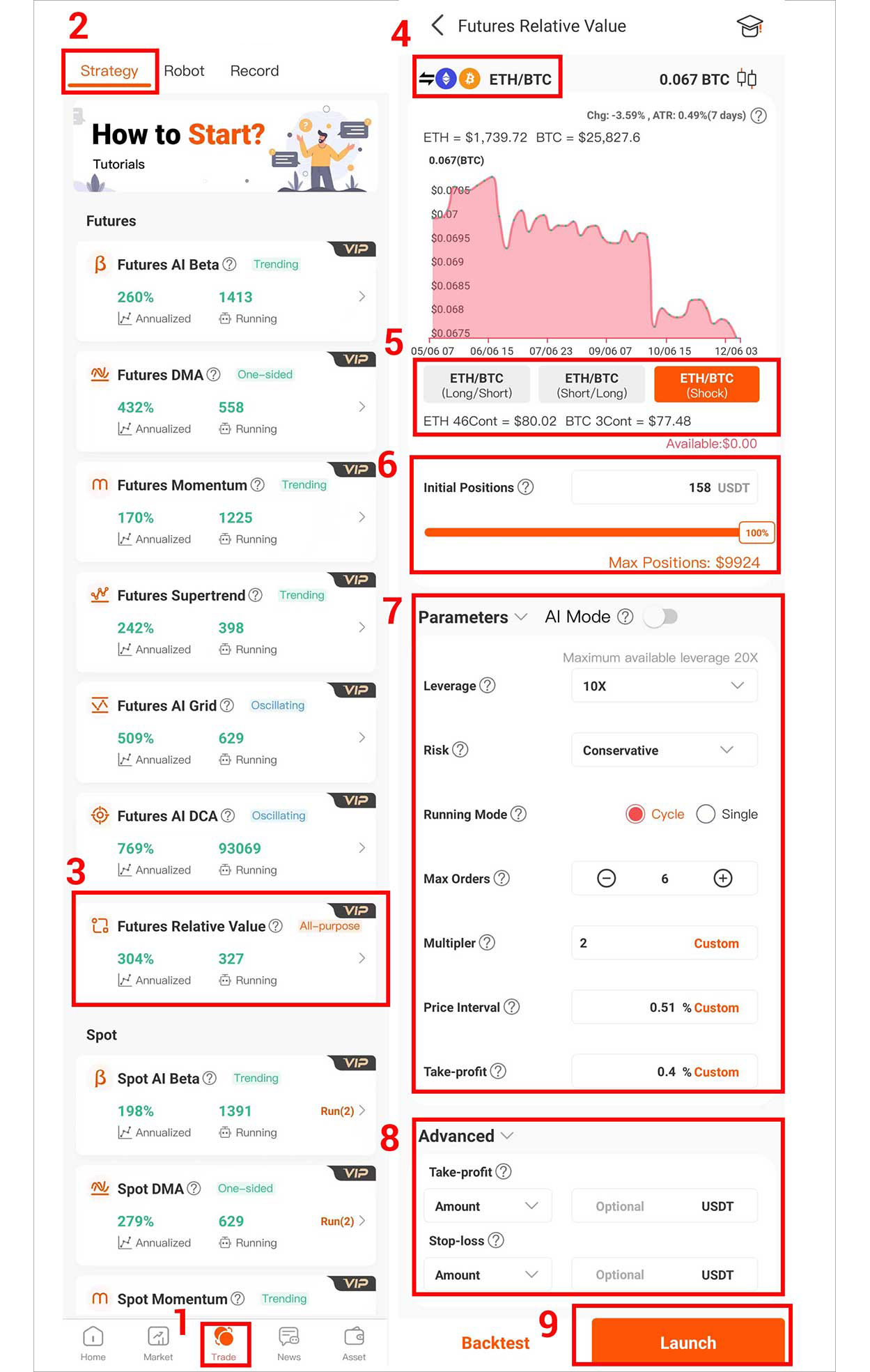What Is the Relative Value Trading Strategy?
Contents:
- What Is the Relative Value Strategy?
- How to configure a crypto portfolio in the Relative Value strategy?
- How to Start a Bot with the Relative Value Strategy?
- Advantages and Risks of the Relative Value Strategy
- How to Improve Relative Value Strategies?
What is the Relative Value strategy?
The essence of the Relative Value strategy is arbitrage, which is to use the pricing difference between associated assets to establish long and short positions to arbitrage the profits of spread that the pricing returns to normal.
The basic principle is that the market’s pricing of certain assets is distorted due to special reasons. When the value of one asset is overvalued and another related asset is undervalued, they can be bought the undervalued asset and sold the overvalued asset until the price of the two tends to converge and close position, so as to obtain the profit from the spread.
Relative Value strategy is a good asset allocation variety. Adding it to a crypto portfolio (i.e., a crypto pair) can better improve the overall risk-adjusted profit while reducing the volatility of the crypto pair. Not only does it meet the needs of the prudent investor, it better meets the asset allocation needs of investors of all risk preference types.
How to Configure a Crypto Portfolio in the Relative Value Strategy?
When the prices of two related cryptos diverge, the Relative Value strategy works in large part by capturing their relative value differentials.
In general, a pair of cryptos that have a relatively stable spread relationship in price over time is first captured. As the spread between the associated cryptos gets wider, or as they get smaller, and then the relationship breaks down or deviates from the usual range, then the magnitude of the change creates relative value opportunities.
Relative Value strategy bot arbitrages by buying one cryptocurrency and selling another at the same time when the price of the cryptos has exceeded its historical range or when the price tends to converge.


Based on the arbitrage nature of the Relative Value strategy, arbitrage opportunities in cryptos mainly exist in the following contexts:
- The first is to compare projects of the same blockchain, allowing investors to arbitrage at the protocol or industry level, but to avoid those public chains that may affect performance because of technical differences.
- The second is to compare the same type of projects on different public chains. There are two different potential goals here: first, similar projects across public chains, which is based on the following judgment – that is, one chain has a comparative advantage over another chain in this application field, which often leads to that protocol performing better than its counterpart on another chain, even if they have similar fundamentals. Second, due to the open-source nature of cryptos, some projects are often “forked”, resulting in completely different project teams operating the same codebase, and project teams, upgradeability, or other specificity factors are a project’s protective shield, there is an arbitrage pricing differentials opportunity.
- The final approach is to compare blockchains from the ground up, around throughput, scalability, user(project) uptake of the public chain, etc. Since the comparison of public chains usually has many different angles, it is recommended that you do some supplementary reading on PoS verification, security, and staking.
AntBot divides cryptos into different sections based on the analysis of the above three aspects, and also provides crypto pairs with the most similar properties for traders’ reference.

How to Start a Bot with the Relative Value Strategy?
Before starting the robot, you need to complete two steps: 1. Bind the API key of the exchange and ensure that the corresponding futures or spot account of the robot has sufficient funds; 2. Purchase the energy for starting the AntBot robot or activate AntBot VIP.
1. Log into your AntBot account to find the [Relative Value] in the [Robot] of the [Trades] interface and click the button on the right to enter the parameter setting page.
2. Choose a crypto pair based on personal criteria and preferences.
3. Select [Long/Short ], [Short /Long] or [Shock]. Here take [ETH/BTC] for example.
- [Short/Long]: Profit will be made when ETH is up more than BTC or BTC is down more than ETH.
- [Long/Short]: Profit will be made when ETH is bigger than BTC’s drop or BTC is bigger than ETH’s rise.
- [Shock]: Profit in all the above four cases.
4. Set [Initial Positions], [Leverage], [Risk Level], [Running Mode], and [Max Order].
- [Initial Positions]: The position amount of the robot’s first open position. Beginners are advised to keep the default values.
- [Leverage]: Using leverage can be regarded as borrowing funds from the exchange to hold positions. The multiple of this position funds relative to the principal is the leverage, and increasing leverage will magnify profits and losses. It is recommended to keep the default value of 5x leverage for beginners.
- [Risk Level]: The greater the risk, the greater the price gap and take-profit percentage when adding positions, and the risk level is radical > steady > conserved.
- [Running Mode]: It is divided into cycle and single. Cycle means that the robot will repeat the next round of opening positions after each take-profit and closing position, and the robot will only stop when it reaches the profit or loss conditions preset in the [Optional]. Single means that the robot will automatically terminate the operation after completing a cross-position take profit.
- [Max Order]: The maximum number that bots are allowed to increase positions consecutively from the state of unopened position.
5. If you want to use the parameters recommended by the system, then you can turn on [Smart Mode]. If you’re going to set them by yourself, then you can fill in the [Size Multiple], [Price gap], and [Take-Profit].
- [Smart Mode]: The parameters of Size Multiple, Price Gap, and Take-Profit cannot be manually modified after turning on Smart Mode. The cloud AI algorithm will monitor market volatility and adjust the parameters in real-time.
- [Size Multiple]: Taking the last open position as the base multiplied by Size Multiple equals the current follow-up investment.
- [Price gap(%)]: Taking the last opening price as a reference, the position will be increased if the market price rises or falls by this preset ratio.
- [Take-Profit(%)]: When the return on invested assets reaches this preset value, the position will be closed and the robot will enter the next cycle.
6. Optionally fill in the [Profit] and [Loss].
- [Profit]:
- Take-profit by Amount: When PnL + Floating-PnL > the preset amount, the robot will automatically close its positions and stop.
- [Loss]:
- Stop-Loss by Amount: When Floating-Loss amount > the preset amount, the robot will automatically close its positions and stop.
7. Click [Launch] to start

Advantages of Relative Value Strategy
- Low market correlation
Relative value strategy does not involve directional trading in the cryptocurrency market. It does not attempt to predict the market or coin price movements but focuses on the changes in price differentials. It maintains both long and short positions, resulting in a lower correlation with the market.
- Low volatility
Price differentials between related cryptocurrencies usually exhibit smaller fluctuations, making relative value strategy more robust compared to other strategies. Including relative value strategy in cryptocurrency allocation helps diversify risk and reduce portfolio volatility. Without leverage, after deducting transaction costs, the strategy tends to generate relatively stable growth without explosive returns.
- Suitable for oscillating markets
Relative value strategy complements trend-following strategies and is more suitable for oscillating markets. From an adaptability perspective, relative value strategy captures the fluctuations in price differentials between related cryptocurrencies, while trend-following strategies face the risk of frequent stop-losses in oscillating markets. Therefore, relative value strategy performs well in such market conditions.
Risks of Relative Value Strategy
The main risk comes from convergence shocks, which occur when the price trends of related cryptocurrencies fail to converge due to certain reasons. Relative value strategy relies on the probability of convergence between related cryptocurrencies to generate profits. However, if the direction deviates and there is an occurrence of low-probability events that prevent the convergence of price differentials, losses can be incurred. Additionally, to achieve higher returns, the strategy may employ leverage, which can lead to significant losses in the presence of low-probability risks.
To mitigate convergence shocks, it is important to diversify strategies within the cryptocurrency assets. Relying on a single strategy or similar strategies can be detrimental if risks materialize. However, when using a combination of multiple strategies, the impact on the overall portfolio is less significant when one strategy faces risks.
How to Improve Relative Value Strategies?
For two currencies that have been alternating between convergence and divergence in the long term, if there is a high probability that this market condition will continue, traders can employ a bidirectional arbitrage approach. This involves simultaneously establishing two robots, one for long positions and the other for short positions, to profit from the normalization of the price differential. In this scenario, one robot focuses on capturing the divergence in the price differential, while the other robot aims to exploit the convergence. By doing so, the efficiency of capital utilization can be doubled, resulting in a 2x effect.
References :
https://www.crystalfunds.com/insights/relative-value-hedge-funds
https://www.barclayhedge.com/insider/hedge-fund-strategy-relative-value-arbitrage
https://www.hfr.com/hfr-hedge-fund-strategy-definitions-relative-value